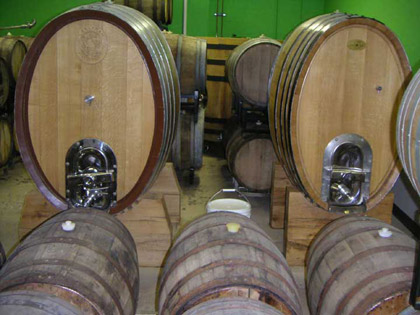
(Note: This post was amended Feb. 24 to eliminate babbling that got in the way of actual story.)
Tomorrow’ s The New York Times carries an article about “tasting Belgian golden ales.” Perhaps surprisingly American beers claimed four the first five spots although half of the 20 beers tasted hailed from Belgium.
The first and fourth favorite beers were from Dexter, Michigan — which as any card-carrying beer geek knows is home to Jolly Pumpkin Artisan Ales. Jolly Pumpkin’s own Oro de Calabaza claimed the top spot and Leelanau Good Harbor Golden, brewed under contract by Jolly Pumpkin, the fourth. Eric Asimov writes:
“Both of these beers were unfiltered, giving them a hazy appearance, and aged in barrels, but beyond that they are completely different. While the Good Harbor was funky, the Oro de Calabaza was spicy, fruity and floral, with soft carbonation and fresh, vibrant flavors. Same man (brewmaster Ron Jeffries), different yeasts, at the least.”
Yes, except of course, for the Dexter microflora, embraced by Jeffries.
“The primary fermentation does indeed use different yeasts,” Jeffries wrote in an email. “The Oro is our ‘house’ strain, and for Good Harbor Golden I use either a cool fermenting clean ale strain, or ferments with a lager at slightly elevated temperatures. I can’t decide which I like best, so I bounce back and forth between the two. Next batch I might blend them. Now that would be cool.
“The Good Harbor oak tun (1200 liters) does produce different flavors than the barrels we age the Oro in. Similar but different. If I had to pick, I would say it tastes most like the 2000L we use mainly for Bam.”
The large barrel that Leelanau bought for use at Jolly Pumpkin is on the left side in the photo above. The rest are Jolly Pumpkin barrels.
I first tasted Good Harbor in the spring of 2007 for All About Beer magazine’s Beer Talk. We liked the beer.
After I had written my notes I took the second bottle the brewery sent to share with friends I get together with semi-regularly.
When you see a bottle holding a brand you’ve never heard of, such as Leelanau, you might as well be tasting blind. But my friend, Bill, took one sniff and declared, “This is Bam.” He knew it wasn’t Bam Biere, the session Saison from Jolly Pumpkin but that was the impression.
Only problem, I said, this beer is 7.5% and Bam 4.5%. “OK, Double Bam,” he said, suddenly looking inspired. “No, Bam Bam.”
I don’t think I ever expected to be reading about the beer I’ll always remember as Bam Bam in The New York Times.
Ha! Stan, that’s a cool pic.. is it a common practice to age in oval barrels like that? Do the dimensional proportions affect the way the yeast ferments?
Joel, The primary fermentation occurs in open fermenters at Jolly Pumpkin, the barrel aging is a secondary process where other wild yeasts and bacterias are present… The size or volume is generally more important to the character (through different oxygen diffusion rates) then the shape, but you could always shoot Jeffries an email and ask him what he thinks.
Could someone please explain to me what a “Belgian-style” ale (or beer) is?
The first sentence of the article contradicts itself. How so? Try reading it like this: A GOOD selection of Belgian-style ales offers an assortment of styles. (I haven’t changed the sentence, only taken out some words.)
The Belgians themselves are not keen on saying things like “my beer is in the same style as his.” In fact, quite the opposite is true.
But why stop there? What is a British-style ale? Or a German-style beer? etc.
Mike – Perhaps nobody tried to answer the question because Americans are beginning to realize there is no “Belgian-style.” But only beginning to. You can still wander into a store and hear I customer ask if there are any new “Belgium beers.” I am not kidding.
I’m surprised to read that sentence when you remove the extra words – lacks the clarity that you expect from the Times. Quite obviously it’s best not to put the words Belgian (or Belgium) in the same sentence together. Leads to immediate confusion.
There’s been some discussion of this at another blog where a commenter wrote:
“Are we to understand that this was supposed to be a “Golden Belgian Ale” tasting? Not a Strong Golden, Abbey, Belgian IPA, Belgian Amber or any other kind of Belgian? I would say this tasting was flawed from the start. First you need to get a group of tasters who know what a Golden Belgian ale is and then get them to be able to read a label.”
I disagree. I liked that you had a range of beers – that might be called strong golden, biere de garde, tripel, etc. but were in fact golden in color, ales and fermented with a yeast sourced from the lowlands that became Belgium in 1830.
This wasn’t a competition. But some beers that share a few similar characteristics together and see what you like (and perhaps what you don’t).
Stan, many thanks for your reply. You are of course correct that there is no such thing as “Belgian style.” Both this term, as well as the term Quadrupel (used with or without the added word “Trappist”), it seems me are nothing more than marketing gimmicks used by brewers who would prefer to increase their sales by riding on the backs of other, more successful brewers.
I find it sad that marketing in the beer industry is often a substitute for quality and/or honesty.